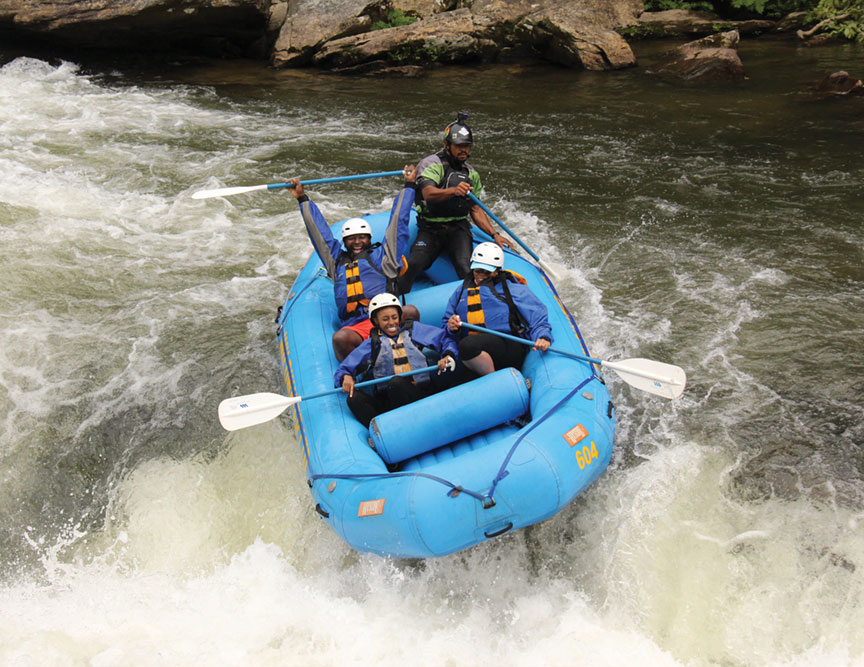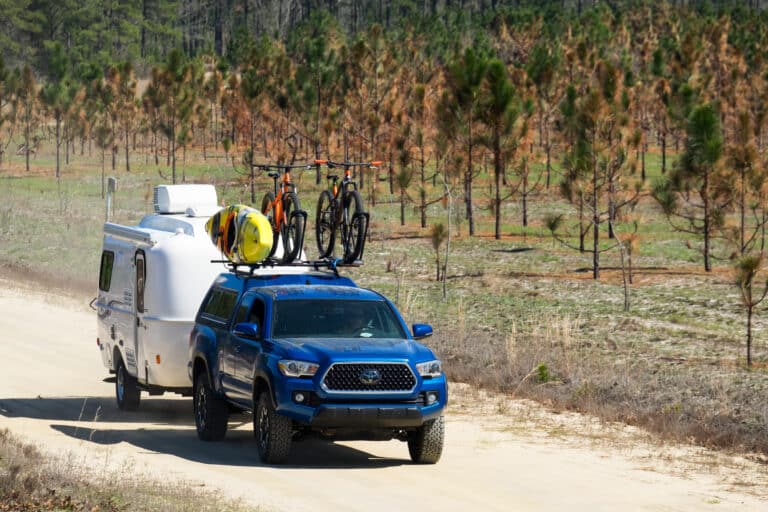A Grassroots Movement Wants to See Two Iconic Southern Rivers Running As Nature Intended
Two miles down a gravel access road that itself sits 12 miles south of Clayton, Georgia, the white pines and tulip poplars fall away to reveal the concrete embankment that is the Tugalo Dam. If you stop on the gravel pull off—which I did one gorgeous November afternoon—you can look north across the lake at the broad blue V that once marked the confluence of the Tallulah and Chattooga Rivers. The rivers are no longer visible, of course—they disappeared nearly 100 years ago when Georgia Power built the 160-foot-tall dam that forms the nearly 600 acres of Lake Tugalo. But as the dam faces millions of dollars of upgrades a decade ahead of a relicensing process, a movement is afoot not to relicense the dam but to remove it, a move that would restore the last four miles of both the Chattooga, a National Wild and Scenic River, and the last two miles of the Tallulah. The very possibility has excited environmental activists, commercial raft companies, and private boaters.
It isn’t hard to see why.
Less than one quarter of one percent of U.S. rivers are designated Wild and Scenic, and few are as iconic as the Chattooga. This is the Deliverance river made famous by the James Dickey novel and John Boorman film, the river a young Governor Jimmy Carter paddled in an aluminum canoe. Every summer thousands of paddlers—from families in bulky commercial rafts to hardcore boaters in sleek kayaks—soak up both the adrenaline and the serenity the river never fails to offer.
I grew up a half hour away in Walhalla, S.C., and, remarkably, if predictably, didn’t appreciate the uniqueness of the Chattooga and its watershed until I was in my twenties.
Descending nearly 2,500 feet from its headwaters at the base of Whiteside Mountain to the Tugalo Dam 56.9 river miles south, the Chattooga offers some of the best whitewater paddling in the East. It’s also a biological hotspot of world renown—a temperate rainforest that excepting the Pacific Northwest receives more rainfall than anywhere in the lower 48 states.
Imagine, I think, standing there overlooking the dam, four more miles to paddle, four more miles to camp by.
Imagine the whitewater, the trails.
Imagine the tremendous ecological benefits to be gained.
It seems too good to be true. I’m from the rural South, and while I know well the region’s beauty and resilience, I also know its resistance to change. It seems almost impossible to imagine.
But I’m not the only one imagining.
“What I want,” Jack Wise tells me, “Is an honest and open conversation about returning the river to its natural course. Let’s make a conscious decision.”
Wise is the CEO of Wildwater, a commercial outfitter based in Long Creek, S.C., but now operating in three states, and he probably knows the Chattooga as well anyone alive. It’s the rush to increase dam capacity without considering alternatives that has Wise and others concerned.
While removing the dam might not make a whole lot of economic difference to Wildwater as a company, it does mean new areas to explore, new rapids, and, most of all, “a river experience of total immersion.” That matters a great deal since the Wild and Scenic Rivers Act was meant to protect not only physical rivers but our experience on them. Every year around 15,000 boaters paddle Section IV, which means their day ends with either a long flat paddle or a boat tow. Either way, the river’s spell is broken, the clean clear water of the Chattooga giving way to the milky silt that gathers in the Lake.
Tugalo Dam was completed in 1923 and, according to Georgia Power’s 2019 Integrated Resource Plan, is nearing the end of its useful life. The dam’s operating license isn’t set to expire until 2036, but in September of 2021 Georgia Power filed a request to amend its operating license. This amendment proposes to modernize the dam to the tune of 24 to 30 million dollars, thus extending the dam’s life for another 40 or 50 years. Having just proposed a collaborative partnership, conservation organizations were caught off guard by the application. A public comment period was over nearly before it started, and on November 24, a few days after I stood on the overlook, six conservation organizations filed a motion urging the Federal Energy Regulatory Commission to study the dam’s removal. If Georgia Power is allowed to preemptively dump the money into the dam, Jack tells me, “this kills the conversation about returning the Chattooga back to its natural flow.”
At the moment that conversation is thriving. The story has been picked up by news organizations not just in South Carolina and Georgia but as far away as Arkansas. Patagonia of Atlanta posted their support on Instagram. American Whitewater put it on their webpage.
It is certainly on the radar of American Rivers, an organization devoted to protecting and restoring rivers. April McEwen, the nonprofit’s project manager who focuses on sustainable water infrastructure and has been involved with dam removal projects all over the U.S., also happens to have grown up paddling the Chattooga. To run the river in its free-flowing natural state is “my lifelong dream,” she tells me. But is it possible?
It’s certainly possible in a physical sense. After all, she tells me, “dams seem larger than life, but they’re actually just another piece of infrastructure that needs repair, replacing, or removal.” Maintaining an old single purpose dam “is expensive and just doesn’t make sense considering modern engineering, technological alternatives.” Some hydroelectric dams helped meet peak power demands—think of the reservoir as a battery—but advances in actual batteries have made many reservoirs inefficient substitutes. Dams also create sediment problems: Lake Tugalo has lost 36 percent of its original capacity. The gathering silt is a growing liability and will only get worse as climate change increases flood events that carry more dirt downstream into the lake.
And there it is again—for all the joy removing the dam would bring to boaters, hikers, and trout fishermen, climate change may well be the most compelling reason to act.
One afternoon I type ‘Migrations in Motion’ into the search engine of my computer and watch—not without a certain amount of awe—as an otherwise blank map of the United States begins to swirl with purple, blue, and yellow light. The map, built by the Nature Conservancy, shows “the average direction mammals, birds, and amphibians need to move to track hospitable climates as they shift across the landscape.” Using something called “electronic circuit theory,” scientists at the University of Washington have plotted projected migratory routes, all of it done in beguiling swirls.
Remarkably, those swirls converge over the Chattooga Watershed. One of the purposes of the map is to make clear the need to “rebuild or maintain connectivity” through these corridors. If we want to give nature a chance in the face of the climate crisis, we have to focus on “[r]emoving fencing, adding wildlife overpasses…to major roadways, and better routing of infrastructure like pipelines and powerlines…” There’s no mention of dams, but there it sits, just as those lines begin to twine into one great pulsing cord.
Migratory routes are just one of the ecological benefits outlined for me by Nicole Hayler, director of the Chattooga Conservancy, a grassroots organization founded in the 1990s to fight the logging and road-building that was threatening the watershed’s three national forests. There is also the presence of Trillium persistens, a federally endangered flower. There is also the green salamander, the only arboreal salamander east of the Rockies. There are, in fact, 22 different endangered and threatened species in the watershed’s 180,000 acres, including the peregrine falcon, swamp pink, bog turtle, and the small whorled pogonia, a rare orchid that has disappeared from much of the United States.
It all culminates in what Nicole calls “the compelling need to act now.”
The purpose of the Chattooga Conservancy is to protect and restore “the eco-system to the greatest extent possible…restoring the habitat under Lake Tugalo would be a huge step in that direction.”
It would also remove the footprint of a significant source of greenhouse gas while opening 600 acres to rewilding and carbon storage and sequestration. It would also, of course, remove a power source. But the plant currently produces only 45MW of hydroelectricity, less than one percent of Georgia Power’s total electric power production. As for replacing that power, American Rivers has noted that “a solar array producing the same amount of energy would require a much smaller spatial footprint—likely a 50-percent reduction—and could be sited outside a waterway in a low-impact manner.”
While it sounds perfectly logical, I’ll admit it takes a lot to imagine a solar array replacing a hundred-year-old dam. It takes a lot to imagine four more miles of the Chattooga and two more miles of the Tallulah. It takes, frankly, a lot to imagine any of it. So it’s good to know that while I stand on the overlook dreaming of a wild, free-flowing river in the southern Blue Ridge, a number of remarkable people are finished dreaming. They are doing.
Imagine that.
Cover photo: A family rafts the rapids of the Chattooga River. Photo courtesy of Wildwater Adventure Centers








